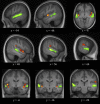Singing in the brain: Neural representation of music and voice as revealed by fMRI
- PMID: 30120854
- PMCID: PMC6866591
- DOI: 10.1002/hbm.24333
Singing in the brain: Neural representation of music and voice as revealed by fMRI
Abstract
The ubiquity of music across cultures as a means of emotional expression, and its proposed evolutionary relation to speech, motivated researchers to attempt a characterization of its neural representation. Several neuroimaging studies have reported that specific regions in the anterior temporal lobe respond more strongly to music than to other auditory stimuli, including spoken voice. Nonetheless, because most studies have employed instrumental music, which has important acoustic distinctions from human voice, questions still exist as to the specificity of the observed "music-preferred" areas. Here, we sought to address this issue by testing 24 healthy young adults with fast, high-resolution fMRI, to record neural responses to a large and varied set of musical stimuli, which, critically, included a capella singing, as well as purely instrumental excerpts. Our results confirmed that music; vocal or instrumental, preferentially engaged regions in the superior STG, particularly in the anterior planum polare, bilaterally. In contrast, human voice, either spoken or sung, activated more strongly a large area along the superior temporal sulcus. Findings were consistent between univariate and multivariate analyses, as well as with the use of a "silent" sparse acquisition sequence that minimizes any potential influence of scanner noise on the resulting activations. Activity in music-preferred regions could not be accounted for by any basic acoustic parameter tested, suggesting these areas integrate, likely in a nonlinear fashion, a combination of acoustic attributes that, together, result in the perceived musicality of the stimuli, consistent with proposed hierarchical processing of complex auditory information within the temporal lobes.
Keywords: fMRI; music; speech; singing; neural overlap; neural preference; pulse clarity.
© 2018 Wiley Periodicals, Inc.
Conflict of interest statement
Authors have no conflicts of interest to declare.
Figures





Similar articles
-
Song and speech: brain regions involved with perception and covert production.Neuroimage. 2006 Jul 1;31(3):1327-42. doi: 10.1016/j.neuroimage.2006.01.036. Epub 2006 Mar 20. Neuroimage. 2006. PMID: 16546406
-
Newborn's neural representation of instrumental and vocal music as revealed by fMRI: A dynamic effective brain connectivity study.Hum Brain Mapp. 2024 Jul 15;45(10):e26724. doi: 10.1002/hbm.26724. Hum Brain Mapp. 2024. PMID: 39001584 Free PMC article.
-
Music listening engages specific cortical regions within the temporal lobes: differences between musicians and non-musicians.Cortex. 2014 Oct;59:126-37. doi: 10.1016/j.cortex.2014.07.013. Epub 2014 Aug 12. Cortex. 2014. PMID: 25173956
-
Stimulus-dependent activations and attention-related modulations in the auditory cortex: a meta-analysis of fMRI studies.Hear Res. 2014 Jan;307:29-41. doi: 10.1016/j.heares.2013.08.001. Epub 2013 Aug 11. Hear Res. 2014. PMID: 23938208 Review.
-
The role of the medial temporal limbic system in processing emotions in voice and music.Prog Neurobiol. 2014 Dec;123:1-17. doi: 10.1016/j.pneurobio.2014.09.003. Epub 2014 Oct 5. Prog Neurobiol. 2014. PMID: 25291405 Review.
Cited by
-
Possible Gender Differences in Classical Music, Flamenco and Fado.Neurosci Insights. 2023 Jan 3;18:26331055221147009. doi: 10.1177/26331055221147009. eCollection 2023. Neurosci Insights. 2023. PMID: 36620125 Free PMC article. Review.
-
Potential Benefits of Music Therapy on Stroke Rehabilitation.Oxid Med Cell Longev. 2022 Jun 15;2022:9386095. doi: 10.1155/2022/9386095. eCollection 2022. Oxid Med Cell Longev. 2022. Retraction in: Oxid Med Cell Longev. 2023 Aug 2;2023:9873067. doi: 10.1155/2023/9873067. PMID: 35757506 Free PMC article. Retracted. Review.
-
A hybrid learning framework for fine-grained interpretation of brain spatiotemporal patterns during naturalistic functional magnetic resonance imaging.Front Hum Neurosci. 2022 Sep 30;16:944543. doi: 10.3389/fnhum.2022.944543. eCollection 2022. Front Hum Neurosci. 2022. PMID: 36248685 Free PMC article.
-
ERP Markers of Valence Coding in Emotional Speech Processing.iScience. 2020 Mar 27;23(3):100933. doi: 10.1016/j.isci.2020.100933. Epub 2020 Feb 24. iScience. 2020. PMID: 32151976 Free PMC article.
-
Introducing the Sisu Voice Matching Test (SVMT): A novel tool for assessing voice discrimination in Chinese.Behav Res Methods. 2025 Feb 3;57(3):86. doi: 10.3758/s13428-025-02608-3. Behav Res Methods. 2025. PMID: 39900852
References
Publication types
MeSH terms
Grants and funding
LinkOut - more resources
Full Text Sources
Other Literature Sources

